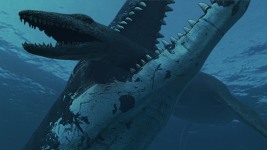
Photo. Pliosaur crushing down on Plesiosaur with 33,000lb bite force (Ill.: Atlantic Productions).
T-REX OF THE OCEAN
According to the press release 17 March 2009 from the Natural History Museum, University of Oslo (website: www.nhm.uio.no), the marine reptile is dubbed Predator X. It`s a new species of pliosaur, an apex predator that patrolled the Jurassic oceans 147 million years ago.
The skull, 'the jewel in the crown for paleontologists', was excavated from the Arctic permafrost during a 2-week field expedition in June 2008, led by Dr. Jørn Hurum from the Natural History Museum, University of Oslo. He was joined by eleven other expedition members, including Dr. Patrick Druckenmiller, a world authority on marine reptiles from the University of Alaska Museum of the North.
Photo. 45 ton Pliosaur attacking a Plesiosaur (Ill.: Atlantic Productions).
The scientists first hit the headlines in August 2007, when they excavated the skeleton of another pliosaur specimen in the same locality. On the last day of the 2007 expedition, Dr. Hurum spotted large bones in the earth. The team placed a marker, took a GPS reading and returned the following summer to excavate. Little did they realize that this new fossil would be even bigger and more significant than the pliosaur they had discovered the year before.
New scientific research reveals that Predator X was approximately 50ft long, weighed in at 45 tons and packed an amazing 33,000lb bite. Its anatomy, physiology and hunting strategy all point to it being the ultimate predator - the most dangerous creature to patrol the Earth's oceans.
Following its excavation in August, several months of cleaning and studying the specimen have revealed…
The size of the skull was confirmed by the discovery of the bassioccipital condyle, a spherical bone present in all mammals and reptiles that connects the base of the skull to the vertebral column.
The robust bone was preserved extremely well, allowing comparison with other species and animals. Dr. Hurum explained, 'The condyle we have found measures 6 inches in diameter, the largest condyle of any known pliosaur species. By comparison, the condyle of a T-Rex measures just 3 inches across - Predator X's skull was at least double the size.' Along with the skull, the team retrieved 20,000 fragments of the pliosaur's skeleton, which are being stabilized and glued together by a dedicated team of students and volunteers at the Natural History Museum, University of Oslo.
To determine how Predator X used its four huge flippers to pursue and kill its prey, Dr. Hurum called in specialist help from biologist Frank Fish at West Chester University , PA , mechanical engineer Laurens Howle at Duke University , NC and biologist John Long at Vassar College , NY.
By calculating the hydrodynamic properties of the flippers using a wind tunnel, Frank and Laurens were able to calculate that Predator X could generate enough power from only 2 flippers to move through the water - the question was, why did it have four?
Further tests were conducted by John Long at Vassar College with four-flippered robot 'Madeleine.' Firstly they used the data already gathered to calculate Predator X's weight for the first time - at 45 tons. The following experiments revealed that when using four flippers, Predator X may have been able to accelerate faster, at the cost of high energy consumption. These results suggest that Predator X could have used its front 2 flippers for cruising, but employed all four flippers when it hunted to accelerate towards its unsuspecting prey.
Dr. Patrick Druckenmiller from the University of Alaska Museum CT scanned a pliosaur skull, loaned from the Natural History Museum in London . This was a unique opportunity to analyze its brain shape and development for clues about Predator X's hunting capabilities and locomotion. Due to the density and size of the pliosaur skull Patrick had to use an industrial CT scanner.
The scan produced a graphical representation of a pliosaur brain, adding valuable data to a completely new field of pliosaur research, and demonstrating that the pliosaur had a small, elongated brain but one that was perfectly specialized for a killing machine. The shape and (proportional) size of the brain bears a resembles to another apex predator: the great white shark.
At St Augustine Alligator Farm and Zoological Park in Florida , Dr. Hurum assisted evolutionary biologist Dr. Greg Erickson from Florida State University in calculating the bite force of this colossal creature. The jaws held in place a set of trihedral teeth, each measuring 12 inches, which clamped down on prey with an estimated 33,000lbs of bite force.
The calculation is one of the largest bite forces ever calculated for any creature. Predator X would have had a bite a bite force was more than ten times the bite force of any animal alive today and four times the bite force of a T- Rex.
All the scientific results will be published in a full scientific paper later this year.
The documentary
Predator X is a documentary produced by Atlantic Productions that followed the expedition uncovering the pliosaur in Svalbard and the scientists throughout their research. It will be screened on History in the USA in May, Britain , Norway and across Europe later this year and distributed by BBC Worldwide.
For further information, preview DVDs, transcripts, stills or interviews, please contact:
Espen Madsen Knutsen - 0047 930 373 96 - e.m.knutsen@nhm.uio.no
Jørn Hurum - 0047 918 360 41 - j.h.hurum@nhm.uio.no
Rebecca Ellis - 0044 (0)20 8735 9318 - rebecca.ellis@zoovfx.com
Trailer from History Channel: Predator X show
For more information about the discovery:
http://www.nhm.uio.no/pliosaurus/english/
Press:
Jørn H. Hurum
Natural History Museum, University of Oslo
j.h.hurum@nhm.uio.no
+ 47 918 360 41
Espen M. Knutsen
Natural History Museum, University of Oslo
e.m.knutsen@nhm.uio.no
+ 47 930 373 96












